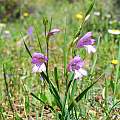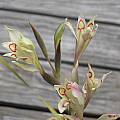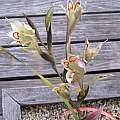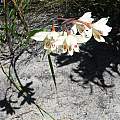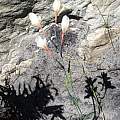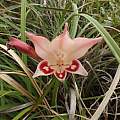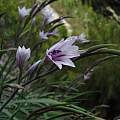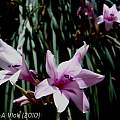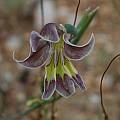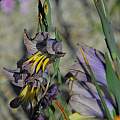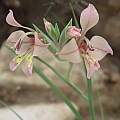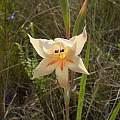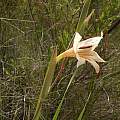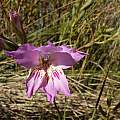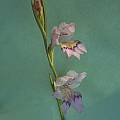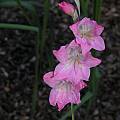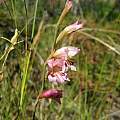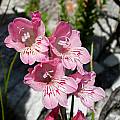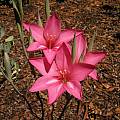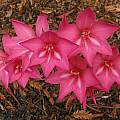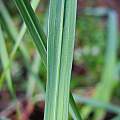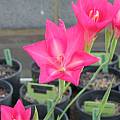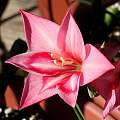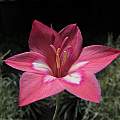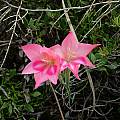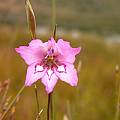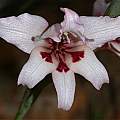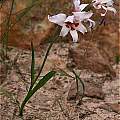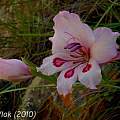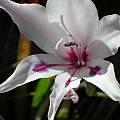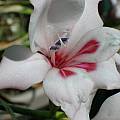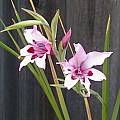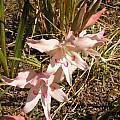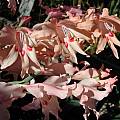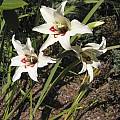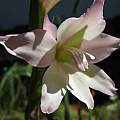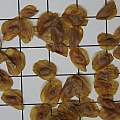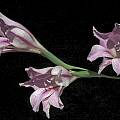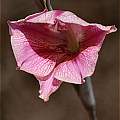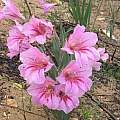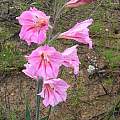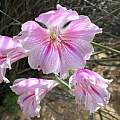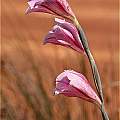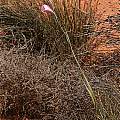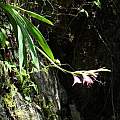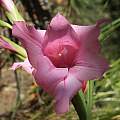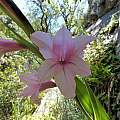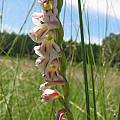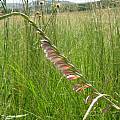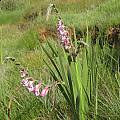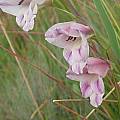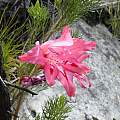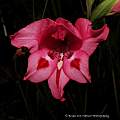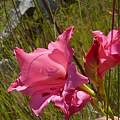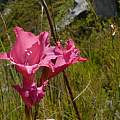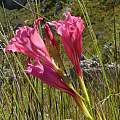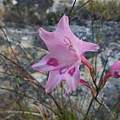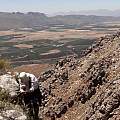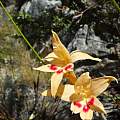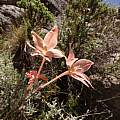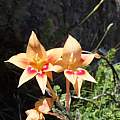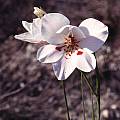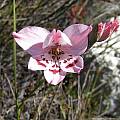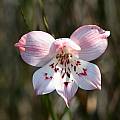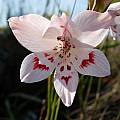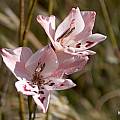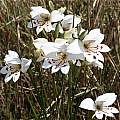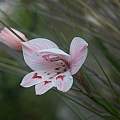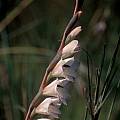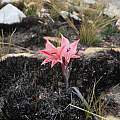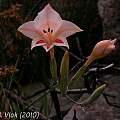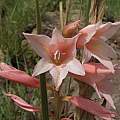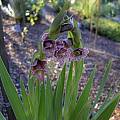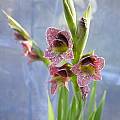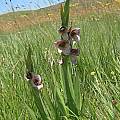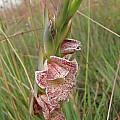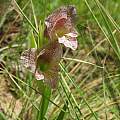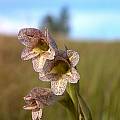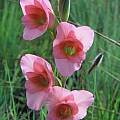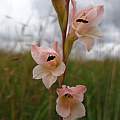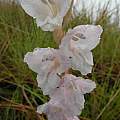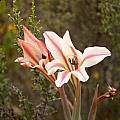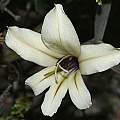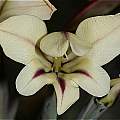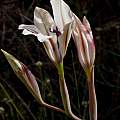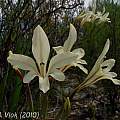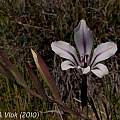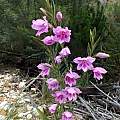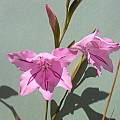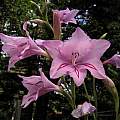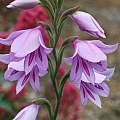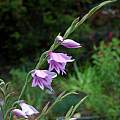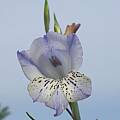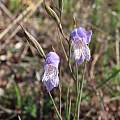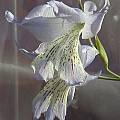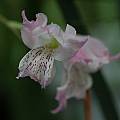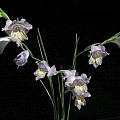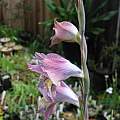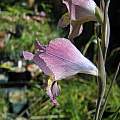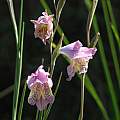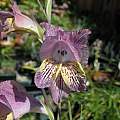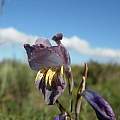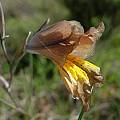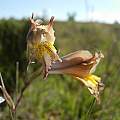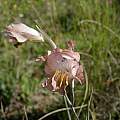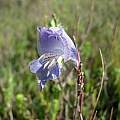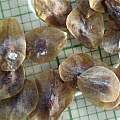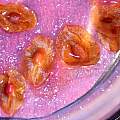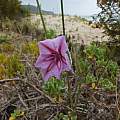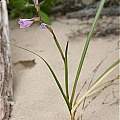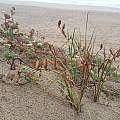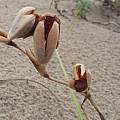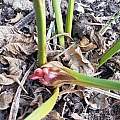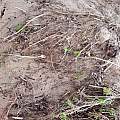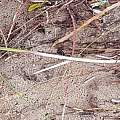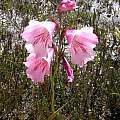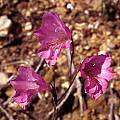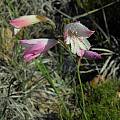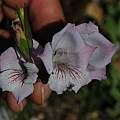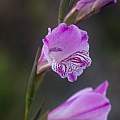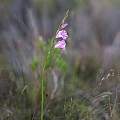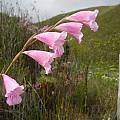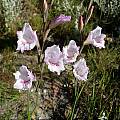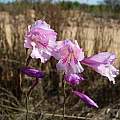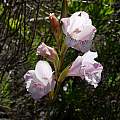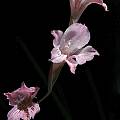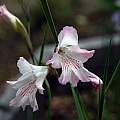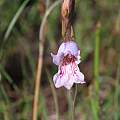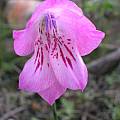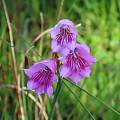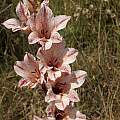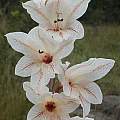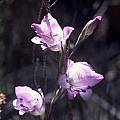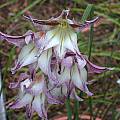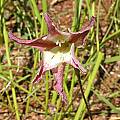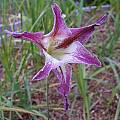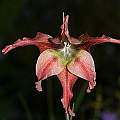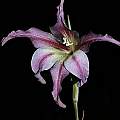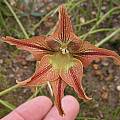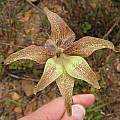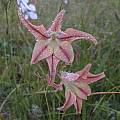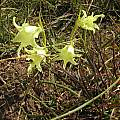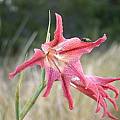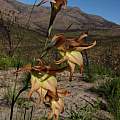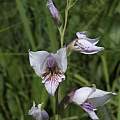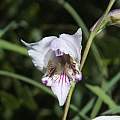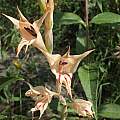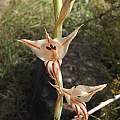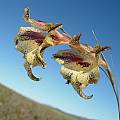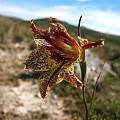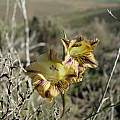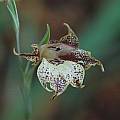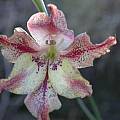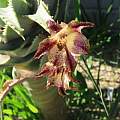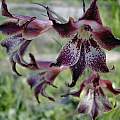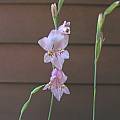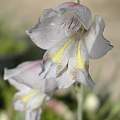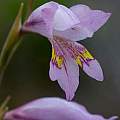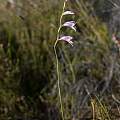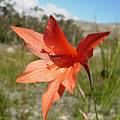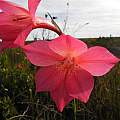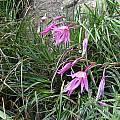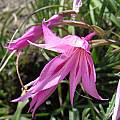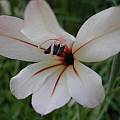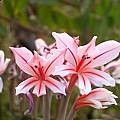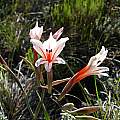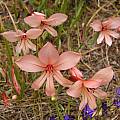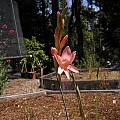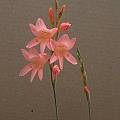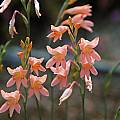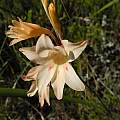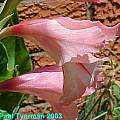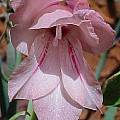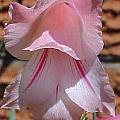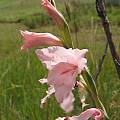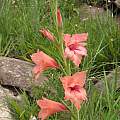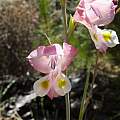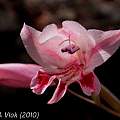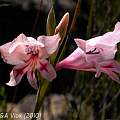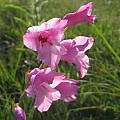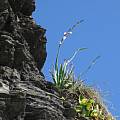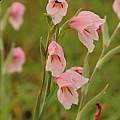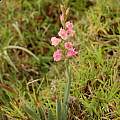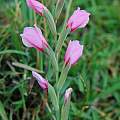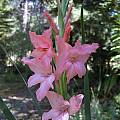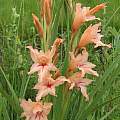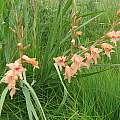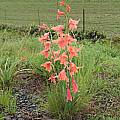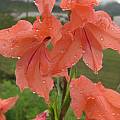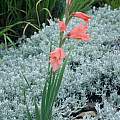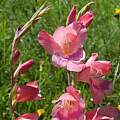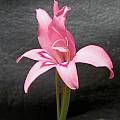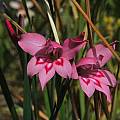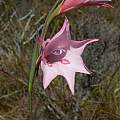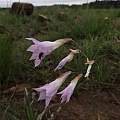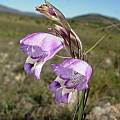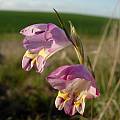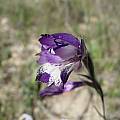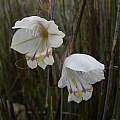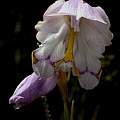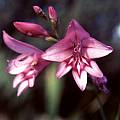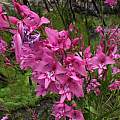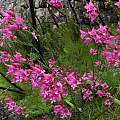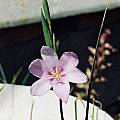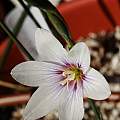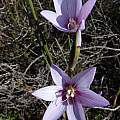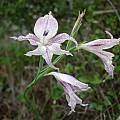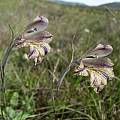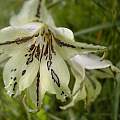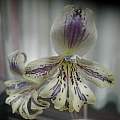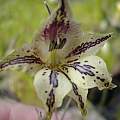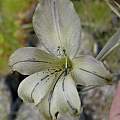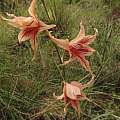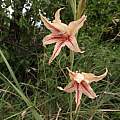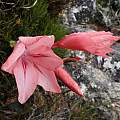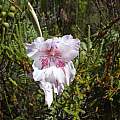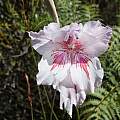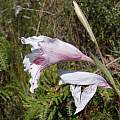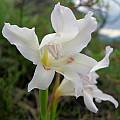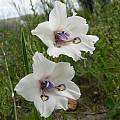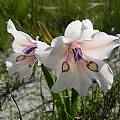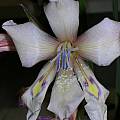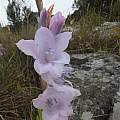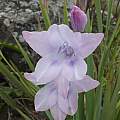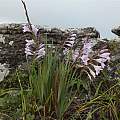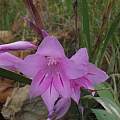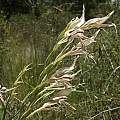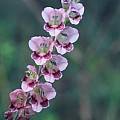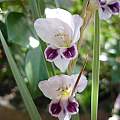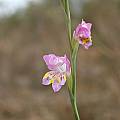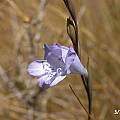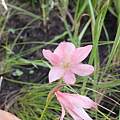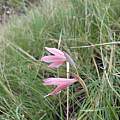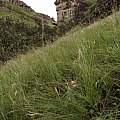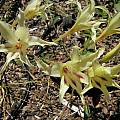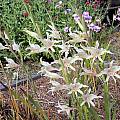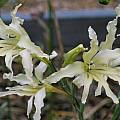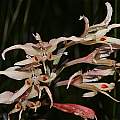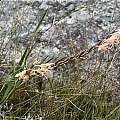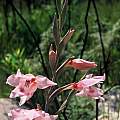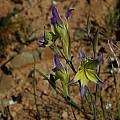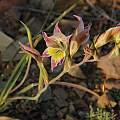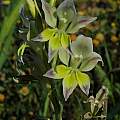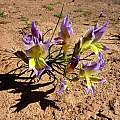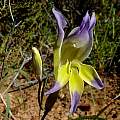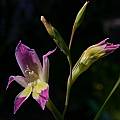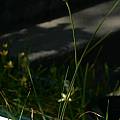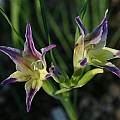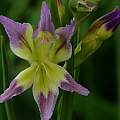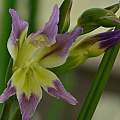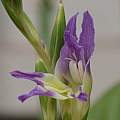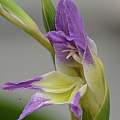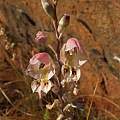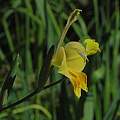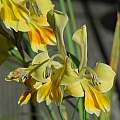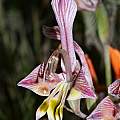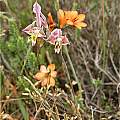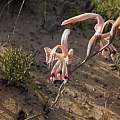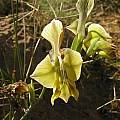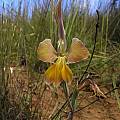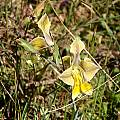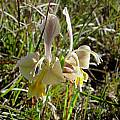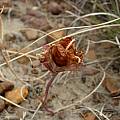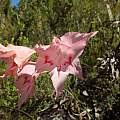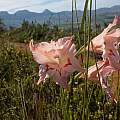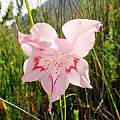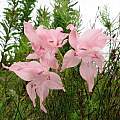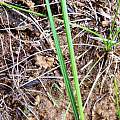From pale rose and mauve to salmon to screaming pink, this color complex offers many shades and the widest range of species in the color indices.
Gladiolus anatolicus is a small species, only 15-30 cm with 3-4 flowers. Growing in Macchie at low elevations in S, SW Turkey and the adjacent Islands, blooming in March-April. Photo was taken in SW turkey by Oron Peri
Gladiolus angustus L. is found in wet places on sandstone soils in the southwestern corner of the southern African winter-rainfall region. Growing from 60 to 120 cm high, it flowers in spring (October and November) with cream to pale yellow flowers with diamond spade shaped yellow markings outlined in dark red on the lower tepals. The species has a very long perianth tube, usually 7 to 10 cm, and the lower tepals are substantially shorter than the upper tepals. It is related to Gladiolus carneus and Gladiolus undulatus. The first two photos from Mary Sue Ittner. The next two photos from iNaturalist taken by Chris Vynbos and shared under a CC BY-SA license. The last photo from Rachel Saunders.
Gladiolus appendiculatus G.J.Lewis is native to the Northern Provinces, South Africa and Swaziland where it grows in grassland on mountain slopes usually above 1800 m up to 2100 m. Growing from 35 to 60 cm, it has softly leathery 6 to 9 long leaves tapering to a sharp or blunt tip and 6 to 14 white to pink unscented flowers marked mauve or pink in the lower tepals, borne on one side. The tepals are unequal in size with the upper three largest and the dorsal arching over the stamens. Anthers have long tails. Flowering occurs in April and May. Photo from Rachel Saunders.
Gladiolus aquamontanus Goldblatt is a local endemic found on streams and wet cliffs in the Swartberg Mountains in the Western Cape. A winter rainfall plant, it grows from 40 to 100 cm, but mostly hangs down where it grows and has sword-shaped grey green evergreen leaves with lightly thickened margins and midribs. The mauve pink flowers are in a 4 to 8 flowered spike. The lower three tepals have a dark purple median streak in the lower two thirds. Flowers are unscented and bloom time is late spring to summer. One of the pbs list members who grows it has found that it never wants to be completely dry. The first photo from Rod Saunders. The next photo from the book Plants of the Klein Karoo courtesy of Jan and Anne Lise Schutte-Vlok.
Gladiolus arcuatus Klatt grows in the dry western part of the winter rainfall area of South Africa. In Namaqualand this species grows among low shrubs in granite derived gravel and in fine grained silt in areas to the south. It has flowers that are dull grey purple, brownish or dark purple, with the lower three tepals yellow in the lower two thirds with the distal third dark purple fading to light grey purple. The dorsal tepal is largest, horizontal and arching forward. Flowers are very fragrant and probably pollinated by long tongued bees. The first photo below could be this species. It was seen in early September 2006 in Namaqualand in the right habitat. The second photo taken earlier that year was taken at Rod and Rachel Saunders' property at Brackenfell. They often sprinkle seed about. I think it also could be this species. Photos 1-2 taken by Mary Sue Ittner. Photo #3 taken by Rod Saunders.
Gladiolus bilineatus G.J.Lewis grows in clay and loamy sand in the fynbos in the Langeberg Center (Southern Cape.) Growing from 20 to 40 cm and flowering March-April, this species has short sword shaped leaves and cream to pink flowers with reddish lines near the base of the lower tepals in a one to three flowered spike. Photos taken March 2016 near Swellendam by Rachel Saunders.
Gladiolus blommesteinii L.Bolus is found on sandstone slopes in fynbos in the southwest Cape. It blooms August to October and grows from 30 to 60 cm high. Flowers are in a one to four flowered inclined spike, mauve or pink with dark longitudinal streaks on the lower tepals. Photo taken in habitat by Rachel Saunders.
Gladiolus brevifolius Jacq. blooms in fall before producing leaves and has small pink, gray or brownish flowers with yellow markings on the lower tepals. It is found on sandstone and shale slopes in the north and south western Cape, South Africa. The first two photos of garden grown plants by Mary Sue Ittner and Bob Rutemoeller. The third photo was taken by Rod Saunders. The last picture was taken near Napier in the Overberg by Cameron McMaster.
Gladiolus carmineus is a narrow endemic of the southwestern Cape coast (winter rainfall) where it grows on rocky sandstone cliffs within the sight of the sea. Flowers appear in the fall (mid February to April) and are pale to deep pink. Each of the lower three tepals and sometimes the upper lateral tepals have a median whitish streak surrounded by a pale mauve halo. There are three to five reduced leaves on the flowering stem. Foliage leaves produced by plants that did not flower appear later and are long and trailing, 8 to 10 mm wide, glaucous with a lightly thickened midrib. They grow during the wet winter and spring, drying off in late spring.
Some PBS members report that they get better results from this bulb in pots if watering is started in late summer (August in California). Others report that it blooms reliably in dry ground even if given no supplemental water. You may need to experiment to see what works best in your climate. It is definitely easier to grow in coastal climates. It has naturalized in the coastal Northern California garden of Bob Rutemoeller and Mary Sue Ittner. They scatter seeds about after the pods split open. The first four photos were taken in this garden. The third shows the long narrow foliage leaves of a clump in February 2014. The fourth is a closer view of a leaf. Mary Sue was asked why these leaves look different from the ones in Nhu's photo below. She did a tour of her garden and found leaves of different widths, some curled, some upright, and some flat. So it may depend on how and where the plants are growing, as well as how old they are. Photo 5 was taken in September, 2005 by David Victor, which flowers in the UK during September, followed later by the foliage. Flower stems and foliage are grey-green. David's plants hold typically four or five flowers on a spike. The last photo is from the summer hemisphere and was taken by Bill Dijk.
Photo 1 is of a slightly lighter-colored form grown by Michael Mace. Photos 2-3 were taken by Nhu Nguyen. Photo 3 shows the pendent habit of the leaves, which makes sense since it grows on cliffs.
Photos taken in habitat near Hermanus, South Africa by Cameron McMaster.
Gladiolus carneus F.Delaroche (syn. G. blandus Aiton ) has a wide distribution in the winter rainfall area of southern Africa and is found in a variety of habitats. It is a variable species that grows to about 50 cm with white to pink large flowers usually with dark spade shaped markings on the three lower lobes. It flowers late spring. This one seeds set very easily and also increases by cormlets. Photos taken in the wild, the first by Cameron McMaster in the Overberg and photos two and three by Andrew Harvie in Table Mountain National Park. Photo four is from the book Plants of the Klein Karoo courtesy of Jan and Anne Lise Schutte-Vlok. The last two photos are close-ups taken by Alan Horstmann.
The first photo was taken by Doug Westfall. The second one was taken June 2003 in Northern California of plants grown from seed, photo by Mary Sue Ittner. The third photo was taken by Jana Ulmer of plants grown from the same seed batch as the picture above. In 2004 both her population and Mary Sue's produced a lot of flowers that bloomed a very long time. Another form has been a reliable bloomer in our Northern California garden where it is planted in the ground and returns each year. Photo four by Bob Rutemoeller. Fifth photo is of an unmarked form, by Gordon Summerfield. Photo of seed on a 10 mm grid by David Pilling
Gladiolus caryophyllaceus (Burm.f.) Poir. grows on sandstone flats and slopes in the winter rainfall area, flowers winter to spring, and has large pink to mauve flowers that are speckled on the lower tepals and fragrant. This species has naturalized in Western Australia. The first four photos by Mary Sue Ittner, Bob Werra, and Alan Horstmann.
The first four habitat shots from Alan Horstmann were taken in the Western Cape. The last two habitat shots by Andrew Harvie were taken east of Koebeeberge in the Western Cape.
Gladiolus cataractarum is a rare endemic of the southern African summer rainfall region. Plants grow on cliffs and steep rocky slopes on quartzite in sheltered, south facing sites. Growing to 70 cm high, this species has eight to nine lanceolate leaves of different sizes and pink unscented flowers with the lower three tepals marked with reddish longitudinal lines. The first photo of the plant in habitat taken by Rod Saunders. Flower photos from Rachel Saunders. They had to walk up a gully to reach it and found it difficult to photograph hanging off the cliff.
Gladiolus crassifolius Baker (syn. G. rachidiflorus, G. thomsonii, G. masukuensis, G. mosambicensis, G. tritoniiformis, G. junodii, G. coranthii, G. gazensis, G. dieterlenii) is a widespread species of eastern southern Africa. It is found also in tropical Africa. Plants in southern Africa usually grow in hilly country in well-drained rocky grassland habitats and bloom late summer. Plants in tropical Africa bloom earlier before the new season’s leaves have developed. Flowers are borne in a 16 to 22 flowered spike and are usually pale to deep pink or light purple. The lower lateral tepals have a dark band of color across the lower half of the limbs. Photos taken by Cameron McMaster at Maclear and Sentinel Peak in the Eastern Cape in 2008.
Gladiolus crispulatus L. Bolus is a rare endemic that is found in the Southwestern Cape on south facing slopes between Swellendam and Riversdale. Growing to 30-40 cm, it has four or five superposed leaves, with the midribs lightly thickened and usually paired on one side and single on the other, and deep pink flowers with triangular median streaks and dark spots in the throat. It is similar to Gladiolus oreocharis but has larger flowers and different leaves and to Gladiolus carneus which also has different leaves and tepal markings. If flowers November-December, but usually only in the first several years after a fire so is rarely seen. The first photograph from Rachel Saunders was taken close to the top of the Langeberg Mountains. The next photos from iNaturalist were taken by Brian du Preez in November in the Western Cape and lennartn in November near Swellendam and shared under CC BY-SA and CC BY-NC licenses.
Gladiolus cylindraceus G.J.Lewis grows on rocky sandstone slopes and ridges in low fynbos vegetation at elevations above 1500 m in the Ceres District of the Southwest Cape. Growing to 50 cm, it has three distinctive linear leaves with the lower one or two basal and the lowermost reaching to between the base and apex of the spike, sheathing the stem and cross shaped in transverse with wide grooves. The unscented flowers are pale pink to salmon with a diamond shaped red mark sometimes with a white to yellow center on the lower tepals. The tube is slender and elongate, up to 52 mm long. It flowers December to January. Photos from Rod Saunders and Rachel Saunders. The first was taken on the Waboomsberg Mountain and the others in the Witsenberg Mountains where there were flowers in colors from pink to apricot to almost yellow.
Gladiolus debilis Ker Gawler is found on rocky sandstone slopes in the southwest Cape, blooming in spring with white to pale pink flowers with red markings on the lower tepals. The first photo by Mary Sue Ittner was taken in September 2001 in an area in the southwest Cape that had burned the year previously and the second was taken by Bob Rutemoeller September 2003 at Boskloof. The third was taken by Ragnhild Crawford. Photos four and five taken near Napier in the Overberg by Cameron McMaster. The sixth photo was taken by Andrew Harvie at Silvermine in Table Mountain National Park. Last photo by Christopher Whitehouse, taken at the Phillpskop Mountain Reserve near Stanford.
Gladiolus densiflorus Baker is a species found in the lowveld and coast of eastern southern Africa. It grows in open grassland, usually on deep soils in high (summer) rainfall areas. It has small, short tubed, cream, greenish, pink, mauve, slate-grey or occasionally orange flowers that are usually minutely speckled with pink to purple spots. Photo taken by Rod Saunders.
Gladiolus dolichosiphon Goldblatt & J.C-Manning was first described in 2009, after a first collection from 1986 wasn't correctly identified as new species. It grows on seasonally wet places on cool south-facing slopes in altitudes above 1300 m in the western little Karoo. The flower spike holding 4 to 7 seven pink to creamy salmon unscented flowers with the lower three tepals each with a pale lozenge-shaped median mark outlined in dark red may have up to two lateral branches. It is a member of the long tubed pink flowered Gladiolus carneus complex but is distinguished from that group by its 5 or 6 linear leaves, creamy pink to salmon flowers with a tube 30-50 mm long and longer than the dorsal tepal, and its late summer flowering (late January to mid February). The first photo from Rachel Saunders was taken the second year after a fire, January 2017. The second photo from the book Plants of the Klein Karoo courtesy of Jan and Anne Lise Schutte-Vlok.
Gladiolus dolomiticus Obermeyer is a rare summer rainfall endemic found on dolomite hills, dry woodland, and dolomite slopes at 1700 m in Makapan's Valley in the Northern province. It flowers in March and April at the end of the rainy season. Growing 70 to 100 cm with rigid hairy leaves with thickened margins and primary and secondary veins, it has a spike of 10 to 17 short tubed pale pink flowers. The lower tepals have a blotch in the midline and the throat is pale yellow. Photo from Rachel Saunders.
Gladiolus ecklonii Lehmann (syn. G. marmoratus, G. inclusus) is widespread in the summer rainfall area where it is found in well watered low grassland. It has flowers that are minutely spotted or dotted pink, red or purple on a white background. The lower tepals are yellow to cream. The flowers may be so evenly covered with uniformly pink or dark red spots that they look that color. From a distance the flowers on my plants looks almost brown. The attractive leaves are bright green in a fan with thickened margins. The species is named after C. F. Ecklon, the plant collector who first sent seeds of it to the Hamburg Botanic Garden. The first two photos are of plants blooming September 2004 in California by Mary Sue Ittner.
The first four photos were taken by Cameron McMaster in the Eastern Cape and the last was taken by Rod Saunders.
Gladiolus exiguus G.J.Lewis grows in open grassland in well drained sites at high elevations in the northern Drakensberg escarpment of Mpumalanga, South Africa. Growing from 30 to 40 cm high, it has 7 to 8 leaves with the lower forming a crowded fan and pale creamy to deep pink unscented short tubed flowers. Photo from Rachel Saunders.
Gladiolus ferrugineus Goldblatt & J.C.Manning grows in marshy grassland or well watered stony slopes in the summer rainfall area in eastern Southern Africa from the Northern Province to North Swaziland. Growing from 35-60 cm, it has 6-8 channeled leaves with the largest leaves twisted, and small white to pink short tubed flowers with rust colored bracts. The lower lateral tepals have cream to pale yellow blotches in the midline. There are two distinct forms. The form from the lower escarpment flowers in summer from late November to early February and has broader leaves and shorter tubes and the form from the upper escarpment flowers in autumn (March and April) and has narrower leaves with thickened margins and twisted blades and longer tubes. Photo from Rachel Saunders.
Gladiolus floribundus Jacq. grows on dry clay, sandy or limestone flats and slopes over a broad area of the winter rainfall Cape. It has white to cream or pinkish flowers with a dark median streak on all of the tepals and blooms in late spring. The first two photos taken by Cameron McMaster near Napier in the Overberg. Photos three, four, and five were taken by Andrew Harvie. Photo three was also taken in the Overberg in the De Hoop Nature Reserve. The last two were taken on a a rocky ridge top in the Swartberg Mountains.
Photos below from the book Plants of the Klein Karoo courtesy of Jan and Anne Lise Schutte-Vlok who write that this species grows up to 60 cm tall with broad grey green leaves. It can be confused with Gladiolus grandiflorus which has a shorter tube.
Gladiolus geardii L.Bolus (syn. Gladiolus robustus Goldblatt) is a late spring to summer bloomer (November to January) found on moist sandstone slopes in the southeastern Cape where it gets limited rainfall year round with a bit less in summer. Growing from 80 to 150 cm high, it is described as having sword shaped leaves and pink flowers with darker markings on the lower tepals in a 6 to 10 flowered spike. The dorsal tepal is inclined. In cultivation in a Mediterranean climate, it is not dormant long. The first photo was taken by Rachel Saunders near Port Elizabeth where some very tall plants were in flower December 2013. One had 7 branches and 14 open flowers. The next two photos were taken by Bob Rutemoeller and the last three by Mary Sue Ittner.
Gladiolus gracilis Jacq. is very similar to Gladiolus caeruleus, but is a bit smaller, has fewer flowers (2 to 5 in a spike), is usually blue to grey, but occasionally pink or yellowish and has dark streaks (instead of spots) on the lower tepals. The lowermost tepal is usually longer in this species instead of mostly the same length as the others in G. caeruleus. It is found mostly on clay slopes (or granite) and blooms in winter. The first two photos were taken by Alan Horstmann. The third was taken by Mary Sue Ittner March 2004 of flowers grown from Silverhill Seed and the fourth in 2007 of more seed grown plants, but this time one with pink flowers. The last photo was taken by Bob Werra
The photos below were taken by Nhu Nguyen of a plant from Telos Rare Bulbs.
All of the pictures below were taken by Cameron McMaster near Napier in the Overberg and illustrate the different forms possible.
The photos taken by M. Gastil-Buhl show seeds from Silverhill Seed dry on a 1 mm grid, then wet.
Gladiolus gueinzii Kunze grows on coastal sand dunes at and above the high tide mark in the southern Cape where it occurs in both the winter and the summer rainfall areas. It produces small cormlets around the base of the buried corm like other species, but also produces a large glossy dark corm that is bouyant in the water and is dispersed to new areas by floating. Growing from 25 to 50 cm high, this species has four to eight mauve flowers with red-purple and white markings on the lower tepals. It flowers in late spring to summer. The first photo was taken by Rachel Saunders. The second photo was taken on the Otter Trail by Andrew Harvie.
Photos from Paul Sieben who comments: "The first photo reflects how close to the sea they grow and flourish. The base of the dune would have been cut by the past equinox spring tides. The second shows how big the pods are and how full they are relative to the flower. All the flowers I have seen have been very similar to the one that Andrew Harvie took (above), they hardly open. The abundance of seed and plants could be due to the closure of our beaches (in 2020) and a lengthy lockdown period here in SA, far less trampling of the dune area as this is at a popular access point".
Photo 3 shows how offset bulbs form around the base of the stem and result in clusters of plants.
In September 2023 "We have had extreme storm surges associated with Spring equinox tides which has stripped the coast of sand exposing the bulbs. This shows the white stem indicating that the bulbs are between 200 and 300 mm below the surface. In my experiences this is very deep for gladioli bulbs, it is possibly to prevent dehydration on the dunes. At least 70 % of the bulbs have been washed away in this one incident".
Gladiolus hirsutus Jacq. has been described under many different names. For a long time it was confused with Gladiolus caryophyllaceus which has larger scented flowers and in the 1972 revision of this genus was named Gladiolus punctulatus but that name is no longer accepted as the correct name. It is widespread in the winter rainfall areas where it is found in a variety of habitats (sandy flats, mountain slopes, rocky outgroups), usually in sandstone or granite soils. It is pink to purple or white with darker streaking on the lower three tepals. The leaves are very hairy, hence the name. The first two photos were taken by Bob Rutemoeller and Mary Sue Ittner in the southwestern Cape in September 2001 in an area that had burned the year before. The next two by Mary Sue Ittner were taken in August 2006 near the Du Toit Kloof mountain pass where we saw these blooming down the slope when we stopped to look at the view including a close-up of the latter when holding the flower helped to get the plant in focus because it was so windy. The fourth and fifth photos were taken in the Phillipskop Mountain Reserve near Stanford, by Christopher Whitehouse.
More habitat photos from Cameron McMaster from Hermanus and Napier in the Overberg.
Photos by Bob Werra, Mary Sue Ittner, and Alan Horstmann of garden plants.
Gladiolus hollandii L.Bolus grows on lower slopes of mountains and on granite outcrops, often in well drained gritty soil in light to moderate shade in the eastern southern African lowveld (Northern Province, Mozambique, Swaziland). Plants grow from 0.6-1.2 m and have a multi-flowered spike of 18 to 30 and sometimes more pale pink minutely dotted dark pink unscented flowers with a reddish median streak running the length of the tepals. Flowering time is mid February to April. Photos by Rachel Saunders.
Gladiolus inflatus Thunb. grows in open habitats on sandstone, often in rocky outcrops or in stony ground among shrubs and restios in the mountains of the Western Cape. It has pink to mauve, purple or violet short tubed flowers. The lower tepals have dark spear or spade shaped purple to red marks in the middle third. The mark on the lower median tepal is usually yellow in the center. This species blooms in spring. Photo taken by Rod Saunders.
Gladiolus liliaceus Houtt. grows on clay slopes over a wide area of South Africa (from the Cedarberg Mountains to Port Elizabeth) and blooms winter to spring. Growing from 30 to 80 cm high, the 1 to 4, sometimes 6, flowers are an inclined spike. The large flowers are brown, dull pinkish red, tan, purplish or cream to greenish yellow and turn bluish to mauve in the evenings when they become intensely clove scented. Depending on the location and the elevation with the lower elevations blooming earlier, this species blooms from late August to December.
The ones grown by Mary Sue Ittner have not been very fragrant and the color change is subtle. Photo 1 was taken by Mary Sue Ittner. Photos 2-3 from Bob Rutemoeller attempt to show the change in color. Photo 2 was taken during the day and photo 3 in the early evening. Andrew Harvie's photos (4-5) show the orangey red color of the day and the more purple color of the night. To ensure correct color balance both photos were taken with a flash and same exposure. He notes that he wishes he could also share the fragrance.
The forms pictured below in the first four photos were all found at Drayton and were blooming August-September 2003. Photos by Bob Rutemoeller including a single yellow one. The fifth photo is of a red flowered one photographed by Cameron McMaster near Bredasdorp in the Overberg. The last photo from the book Plants of the Klein Karoo courtesy of Jan and Anne Lise Schutte-Vlok.
Gladiolus loteniensis is a narrow endemic known only from the upper Loteni River valley in KwaZulu-Natal. It grows in flat sites along the riverbank in black peaty soil and in the lee of low cliffs or boulders. Growing from 30 to 60 cm high, it has 4 to 7 leaves. The lower and longest basal leaves are narrowly lanceolate to linear with a lightly thickened and raised midrib and the remaining leaves are inserted between the middle and upper quarter of the stem and are channelled. Flowering occurs early December to mid January with a straight to slightly flexed spike of 6 to 12 unscented pale lilac short tubed flowers. The lower three tepals are veined violet on a cream to pale yellow background in the lower two thirds; the upper third is pale or dark lilac. Photos taken by Rachel Saunders December 2014.
Gladiolus macneilii Oberm. is a narrow endemic of the eastern escarpment of northern Mpumalanga, South Africa where is grows in loamy soil in rocky ground in grassland and light woodland. Growing from 70 to 90 cm with a slightly inclined spike of 7 to 17 flowers, it blooms in March and April. Flowers have a very long perianth tube (40 to 45 mm) and are cream to pale salmon pink, each with a narrow, dark red, longitudinal median streak. The upper three tepals are the largest with the dorsal tepal arching over the stamens and the lower three tepals are united at the base with narrow and recurving tips. The anthers have short appendages and long purple tails. Photos by Rachel Saunders.
Gladiolus maculatus Sweet extends across the southern coast and immediate interior of the winter rainfall area to the Eastern Cape where it is often found growing in heavy soils in renosterveld. Flowers are dull yellow to lilac and speckled with brown or purplish spots. They are long-tubed and fragrant during the day and the evening. The first three pictures were taken by Cameron McMaster near Napier and Bredasdorp in the Overberg.
The first two pictures below are of garden flowers taken by Mary Sue Ittner December 2007 and January 2009. The next two were taken by Alan Horstmann and the last by Dirk Wallace.
Gladiolus martleyi L.Bolus syn. Gladiolus pillansii grows on sandy and rocky flats in the northern and southwestern Cape and blooms in the fall on a flowering stalk without leaves. Growing from 30 to 60 cm, it has usually scented pale to pink or lilac flowers. The lower lateral tepals each have a transverse band or a spear shaped yellow mark edged darker pink or purple in the upper half. The first photo by Bob Rutemoeller shows one grown from IBSA seed from Betty's Bay. The second photo was taken by Dirk Wallace. Other photos taken by Christopher Whitehouse in the Phillipskop Mountain Reserve.
Gladiolus meridionalis G.J.Lewis is found in the Southern Cape from the Overberg to Port Elizabeth (both winter and summer rainfall areas) and flowers from June to August. The distribution is discontinuous. Plants grow in stony sandstone soils in low fynbos on mountain slopes and flats that are usually in sight of the ocean. The populations in the west of the range have dark pink to salmon flowers and those in the east have cream to pinkish orange flowers. Flowers are adapted for pollination by sunbirds with a long perianth tube. An article here describes a rare finding of this species. The first photograph from Cameron McMaster was taken on the farm Fairfield in the Napier district where it occurs on sandstone slopes. The second photo was taken by Rachel Saunders.
Gladiolus microcarpus is endemic to the Drakensberg in KwaZulu-Natal, the Free State, South Africa and Lesotho. Plants grow on rocks and steep cliffs where their stems hang downward from vertical rock faces and their stems are anchored in crevices. During the growing season the habitat is moist. Flowers are bright pink with a broad white longitudinal zone in the lower two thirds of the lower three tepals and a narrow reddish purple streak in the midline. Photos taken by Cameron McMaster at Sentinel Peak, February 2008.
Gladiolus miniatus is found on coastal limestone outcrops from Hermanus to Agulhas. Spring blooming flowers are salmon with red along the midline. The first photo was taken by Dirk Wallace and the second and third by Cameron McMaster at Arniston. The last two photos were taken by Mary Sue Ittner in May 2005 when they were blooming for the first time from seed in Northern California with California bulb companions Brodiaea jolonensis, Allium unifolium and Triteleia hyacinthina in bloom in the same raised bed.
Gladiolus monticola is found on rocky sandstone slopes in the southwestern Cape. There are populations on Table Mountain. It has pink to apricot flowers with darker pink markings on the lower tepals and blooms summer into fall before the single leaf is produced. The first two photos by Bob Rutemoeller. This first photo shows it as the only bulb blooming in one of our raised beds that only has bulbs from winter rainfall areas, blooming in July 2003 in the northern hemisphere. The leaf in the picture is of another Gladiolus that bloomed a month earlier. In the second photo we put cardboard behind the flowers to get the close-up that shows the details better. The third photo was taken years later by Mary Sue Ittner. The last photo from Rachel Saunders was taken on Table Mountain February 2011.
Gladiolus mortonius (formerly Gladiolus ochroleucus var. macowanii) is a summer rainfall Eastern Cape species that grows in open stony grassland. Although it resembles Gladiolus ochroleucus, the long tubed pink flowers with a red median streak on the lower tepals and a few reddish longitudinal lines parallel are much larger (tube is 30-45 mm). It is a gorgeous little gladiolus that grows successfully in a pot, producing flower stems around 8-9 inches tall, with comparatively large flowers that face slightly downwards. The photo (face) is taken upwards into the flower to show detail. This has had a succession of flowers since late February (in Australia) and is now sending up another spike in mid April just as the last of the previous flowers have faded. The first three photos by Paul Tyerman.
The photos below were taken in the Eastern Cape by Cameron McMaster February 2008. The first was taken at Andriesberg and the last two at Cathcart.
Gladiolus mostertiae is found in wet sandy soils in the Bokkeveld Mountains in the Northwest Cape. Growing 25 to 30 cm high, this species has linear leaves with a thickened midrib and pale pink flowers with yellow-green markings on the lower tepals. It flowers November to December. Photo taken by Rachel Saunders November 2013 near Nieuwoudtville in a year with late rainfall so the soil was still wet when it bloomed.
Gladiolus nigromontanus Goldblatt is a rare South African species that occurs only on rocky outcrops on sandstone slopes in the Swartberg Mountains. Flowering in autumn (March) and best a few years after a fire, it grows to 30 cm with narrow leaves and small white long tubed flowers suffused light pink and marked with red and yellow on the three lower lobes. Flowers are in a 3 to 6 flower spike. Photos from the book Plants of the Klein Karoo courtesy of Jan and Anne Lise Schutte-Vlok.
Gladiolus ochroleucus grows in grasslands and light bush or woodland in the Eastern Cape. Flowers are either shades of pink, sometimes light purple or reddish, or whitish or yellow flushed brownish on the reverse. The lower tepals are white in the lower half sometimes with dark red-purple median streaks. The first two photos by Cameron McMaster were taken January 2008 in the Eastern Cape. Photos number three, four, and five were taken near Morgan Bay by Bob Rutemoeller and Mary Sue Ittner.
Gladiolus oppositiflorus Herb. is found in the southern part of the summer rainfall area where it grows in open grasslands and often in rocky sites where there is some protection from predators. Flowers are salmon to pale pink or mauve, with the lower three tepals paler in the midline and having a reddish to purple median streak. This species blooms summer into fall. The first two photos by Mary Sue Ittner of a plant growing in the ground in Northern California and blooming late August-September 2004. The last two photos were taken by Cameron McMaster at Maclear in the Eastern Cape February 2008.
A shorter-stemmed form with salmon colored flowers was described as Gladiolus salmoneus Baker and later considered to be Gladiolus oppositiflorus ssp. salmoneus (Baker) Oberm. Although this subspecies is still recognized by Kew, Goldblatt and Manning in Gladiolus of Southern Africa did not think the differences warranted subspecies treatment. The first two photos of this form taken in the Eastern Cape January 2008 by Cameron McMaster. The last photo is from Rachel Saunders.
Gladiolus ornatus Klatt is found on marshy sandstone and granite slopes in the Southwestern Cape, South Africa. Growing from 25 to 35 cm high, it has linear leaves and pink unscented flowers in a funnel shaped tube in a one to three flowered spike. The lower tepals each have a spear to spade shaped white median streak edged in dark pink and the lower part of the throat is white streaked with dark pink. Flowering is from September to November. Photo by Rachel Saunders.
Gladiolus paludosus grows in Mpumalanga in marsh and vlei habitats that are wet much of the year. It has short-tubed pink or mauve, occasionally red unscented flowers; the lower lateral tepals have a broad diamond-shaped to semicircular band of dark mauve or purple across the midline. Flowering time is mid October to mid November. It is very similar to Gladiolus crassifolius, but grows in a different habitat, flowers earlier, and has softer textured leaves and bracts. Photo taken by Rachel Saunders January 2015, much later than the usual flowering time.
Gladiolus pappei grows in marshes on sandstone slopes in the southwestern Cape. It flowers in spring. The first two photos show a plant that was grown from Silverhill seeds sown in September 2001 and first blooming in June 2003. Photos by Bob Rutemoeller and Mary Sue Ittner. The last photo was taken by Rachel Saunders.
Gladiolus parvulus Schltr. is restricted to the southern half of KwaZulu-Natal, South Africa, into Lesotho where it grows in thin soil on sandstone pavements or in cracks in sandstone outcrops at elevations up to 3300 m. Growing from 15 to 35 cm, it has two leaves, the larger sheathing the stem and the second a small bract-like leaf immediately below the lowest flower. It has small horizontal to almost nodding light pink flowers with equal tepals. The flowers have been described as looking more like an Ixia or a Dierama. It flowers October to early December. Photo from Rachel Saunders.
Gladiolus patersoniae is widespread in the southern African winter rainfall areas. It occurs in exposed rocky habitats in the interior ranges of the Cape Floral region, but also near the coast at Cape Infanta and on stony alluvial flats near Worcester. It grows on soils derived from sandstone. Plants grow to 50 cm and have narrow cylindrical leaves. The bell like short tubed and sweetly scented (similar to apple and carnation) pale to deep blue, slate, grey or cream flowers are pollinated by long tongued bees. The lower three tepals have a transverse yellow band usually outlined in dark blue or purple. Flowering occurs in late winter to spring, earlier at lower elevations. The first five photos by Cameron McMaster. His last one was taken August 2012 at the top of Potjiesberg Pass south of Uniondale (Eastern Cape) where it was growing with Gladiolus mutabilis. The last photo from the book Plants of the Klein Karoo courtesy of Jan and Anne Lise Schutte-Vlok.
Gladiolus phoenix Goldblatt & J.C.Manning is a rare local endemic restricted to moist backs and ravines in the Bain's Kloof Mountains. This plant appears to need fire to stimulate bloom. Flowers are pink with a white spear shaped mark outlined in deep pink on the lower three tepals. The first photo by Alan Horstmann. The next two were taken by Rachel Saunders post fire near Bainskloof, November 2015.
Gladiolus quadrangulus (D.Delaroche) Barnard (syn. Ixia linearis, G. linearis, G. biflorus) is found in the southwestern Cape in sandy soil in seasonally wet, poorly drained and sometimes brackish habitat. Goldblatt & Manning report that it has been eliminated from most of its original range, and that "its long-term survival in the wild is unlikely." Fortunately, it is relatively easy to grow in cultivation, where it can be treated like a typical winter-growing Glad. It has pale pink, mauve or white flowers. The tepals have darker veins. It blooms late winter into spring. The shape of the flowers is reminiscent of an Ixia, and unlike most Gladiolus it does not produce nectar. Goldblatt & Manning speculate that it is adapted to pollination by pollen-eating insects. First photo by Alan Horstmann. Second photo by Michael Mace of a plant whose name tag was lost, but which is almost certainly G. quadrangulus. The final photo was taken by Rachel Saunders who photographed it in the wild.
Gladiolus recurvus Linnaeus occurs in shale derived soils from Ceres to Bredasdorp and flowers from June to October depending on the elevation. The fragrant flowers are pale gray to cream, yellowish or pinkish with purple lines and dots on the lower tepals and sometimes spotted or lined in the midline on the upper tepals as well. The first two photos were taken by Cameron McMaster in the Overberg. The other photos by Dirk Wallace show variation in the markings on flowers.
Gladiolus reginae Goldblatt & J.C.Manning is a rare species known from only two populations where plants grow in open woodland in rocky outcrops, partially shaded by shrubs and trees, in heavy metal-enriched soils. Growing from .4 to 1.5 m, it has 7 to 16 unscented long tubed flowers in an erect spike. Flowers are pale flesh-pink flushed deeper salmon and the lower three tepals are flushed deep red in the basal third with longitudinal lines. The upper three tepals are flushed deep red at the base. Flowering takes place from mid March to mid April, but may skip a year if it's too dry. Goldblatt and Manning report that flowers are pollinated by long-proboscid flies, but also attract ants with sweet droplets from the tips of the bracts, likely for protection from other insects.
Photos by Rachel Saunders shows specimens found in the Blyde River Canyon Nature Reserve (situated in Mpumalanga).
Gladiolus rhodanthus J.C. Manning & Goldblatt is distributed on rocky sandstone slopes at high elevations in the southwest Cape. Growing from 30 to 50 cm, it has hairy linear leaves and pink flowers with red markings on the lower tepals. Photo by Rachel Saunders taken with some effort since it was quite a climb (in light rain/mist) to get to it. It was growing at 1700 m in cracks in the cliffs.
Gladiolus roseovenosus Goldblatt & Manning is a rare winter rainfall species that grows in peaty sandstone soil on well drained slopes in the coastal foothills of the Outeniqua Mountains in the southern Cape. Plants grow 20 to 40 cm high and the long tubed creamy pink unscented flowers with red nectar guides are in a 2 to 4 flowered spike. Blooming time is summer into fall, between February and April. Photos taken by Rachel Saunders.
Gladiolus rudis Licht. ex Roem. & Schult. grows on sandstone slopes in fynbos in the southwestern Cape and blooms in spring. It has 2 to 5 cream to pale pink flowers on a spike. The lower tepals have spear-shaped markings and the perianth tube is funnel shaped. The first three photos taken by Cameron McMaster near Caledon and Fairfield in the Overberg and the last taken by Alan Horstmann.
Gladiolus salteri G.J.Lewis is a winter-grower found in a small area of granite hills in Namaqualand. It has thin pink tepals, with red and cream chevrons on the lower ones, and is believed to be pollinated by long-tongued bees. You can see a photo of it here.
Gladiolus saxatilis Goldblatt & J.C.Manning, syn. Gladiolus lithicola Goldblatt & J.C.Manning, is a narrow endemic of the summer rainfall region where it occurs between Mariepskop and Graskop along the lower Drakensberg escarpment of Mpumalanga growing in shady places on sandstone rocks and cliffs of black reef quartzite. Growing from 45 to 80 cm high, it has six to ten fan like relatively broad (18 to 35 mm) soft textured leaves reaching to the base and middle of the spike and a slightly inclined spike of 9 to 16 relatively large pale pink to mauve unscented flowers. The lower tepals have weakly defined pale mauve, linear diamond shaped median nectar guides and the perianth tube is narrowly and obliquely funnel shaped. The floral bracts are purplish when young, becoming dry and rust-colored after flowering which occurs mid March to late April, possibly into May. Photos from Rachel Saunders.
Gladiolus scabridus is restricted to the mountains of northern KwaZulu-Natal and southern Swaziland where it grows at elevations of 1000 to 2000 m in well-drained, rocky habitats. Flowering from December to late January at lower elevations into February at cooler, wetter sites, it has an erect spike of 10 to 16 flowers. The unscented long tubed flowers are bright pink with a narrow white longitudinal zone in the lower two thirds and a narrow reddish streak in the midline. Photo taken by Rachel Saunders in KwaZulu-Natal January 2015.
Gladiolus sekukuniensis P.J.D.Winter is known from two sites in Sekukuniland, west of the Transvaal Drakensberg where it is found on alkaline soils in open woodland and flowers from March to April. It grows from .6 to 1 m and has linear leaves with a thickened and raised midrib and a spike of 8 to 17 flowers. Flowers are white or cream to pale salmon pink with a narrow, dark red, longitudinal median streak on each tepal except for the dorsal where the streak is sometimes incomplete or lacking. The lower tepals sometimes have a yellow streak in the center. Flowers are distinctively windowed (in profile there is gaping between the dorsal and upper lateral tepals) with the tepals unequal and narrowed below into claws with twisted and undulate tail-like tips. Photos by Rachel Saunders.
Gladiolus serpenticola Goldblatt & J.C.Manning is endemic to the Barberton District of Mpumalanga, South Africa where it grows in serpentine soils. It is tall (75-150 cm) with small pale pink flowers with pale mauve markings on the lower lateral tepals. Photos by Rod Saunders and Terry Frewin.
Gladiolus subcaeruleus G.J.Lewis grows on sandy loam and clay slopes in renosterveld in the southwestern Cape and flowers in the fall. It is described as having pale blue to mauve flowers with yellow transverse to spear shaped markings outlined in purple on the lower tepals. The dorsal tepal is hooded over the stamens. Photos taken by Cameron McMaster in the Overberg, Bot River and Napier show variations from the description.
Gladiolus symonsii F.Bolus is a montane species growing at 1900 to 3200 m on grassy slopes and cliffs in the Drakensberg range of KwaZulu-Natal and eastern Lesotho. Plants are 25-45 cm high and flower in early to midsummer, December and January. Flowers are bright pink to pale rose, whitish in the throat and relatively small with a short tube. Stems are unbranched and the spikes bear only two to four flowers. There are three leaves with the lowermost longest, sheathing the lower third of the stem. This species has rarely been collected and three plants were discovered by the photographers Rod Saunders and Rachel Saunders in an area that had burned on a dark day with a storm coming making it difficult to get good photographs.
Gladiolus undulatus is a late spring summer flowering plant found on marshy sandstone slopes in the northwest and southwest Cape. It has whitish to cream flowers with pink diamonds on the lower tepals. Although it is similar to Gladiolus carneus, it has a much longer tube with wavy tepals. Given the right conditions in some areas outside of South Africa this species has naturalized. The first three photos were taken by Mary Sue Ittner of flowers blooming various years in June in northern California. Photos 4-5 were taken in habitat by Andrew Harvie near Bainskloof. The last photo was taken by Rod Saunders.
Gladiolus venustus G.J.Lewis has flowers that are shades of purple to pink and sometimes dull yellow with yellow markings on the lower half of the lower tepals. It is widely distributed across the interior of the winter rainfall areas of southern Africa where it is found in dry habitats on clay and sandstone slopes. The primary pollinators are long tongued bees. It can be confused with Gladiolus scullyi and it has been included in that species at one time but it usually more colorful than that species which is usually greenish cream to yellow brown or beige and more highly scented. The dorsal tepal on Gladiolus scullyi is also more horizontal, inclined over the stamens and the upper two lateral tepals curve outward in an arc. But the distinctions are sometimes difficult to tell, especially in areas where they both grow. An example of this difficulty is shown in the third picture which I suppose could be either species. The first two photos by Mary Sue Ittner and Bob Rutemoeller were taken September 2006 in the Roggeveld. The third photo from Mary Sue Ittner was taken near Nieuwoudtville. The last two photos were taken by Cameron McMaster September 2011 near Middelpos in the Roggeveld.
Photos below were taken by Bob Werra.
Photos below were taken by Arnold Trachtenberg.
Gladiolus vernus Obermeyer grows in rocky grassland in the Blyde River Canyon area in Mpumalanga. It flowers in July and August in completely dry conditions before the first rain starts. Foliage leaves are produced afterwards in September or October. Flowers are pale to deep pink, or cream, with the upper tepals darker above and with a yellow zone on one or all of the three lower tepals. This zone is sometimes edged with dark pink or purple. The lower halves of the lower tepals are speckled with pink. Flowers are unscented and plants grow from 45 to 75 cm high. Photo from Rachel Saunders.
Gladiolus virescens grows on sandstone or clay slopes in a broad area flowering in late winter to spring. Flowers are yellow to pink with dark veins and very fragrant. The first photo shows a pink one grown by Alan Horstmann and photographed by Bob Rutemoeller. The next two photos were taken by Mary Sue Ittner of plants grown from seed. Photos 4 and 5 were taken by Andrew Harvie at the De Hoop Nature Reserve. The last photo was taken by Rachel Saunders of an unusual color form found flowering in December, much later than the usual time.
Two different color forms were photographed in the southwest Cape September 2003 by Bob Rutemoeller. The next three photos taken by Cameron McMaster at Boskloof and near Napier, both in the Overberg. The last picture shows the seed pods.
Gladiolus virgatus Goldblatt & Manning is restricted to cool, well watered slopes of the coastal ranges of the southwestern Cape. Poorly collected, it has been found in clay soil on ground covered with scattered sandstone boulders. Growing from 30 to 60 cm high, it has linear leaves with slightly thickened margins and midribs. The pale to deep pink or nearly white large unscented flowers are marked on the lower tepals with a spear shaped whitish median streak edged with a reddish v shaped mark, speckled in the throat and are in a two to four flowered inclined spike. The dorsal tepal is inclined over the stamens. This species flowers September-November. The first two photos from Rachel Saunders taken in the Helderberg Nature Reserve. The next three photos from iNaturalist taken by linkie in the same place in November and shared under a CC BY-NC license.
